What conclusions can we draw about the hearing care market from the recent economic downturn? Although few will remember 2009 as a stellar year for hearing aid sales, the number of units sold rebounded by 8.5% overall (4.9% for the non-VA private sector) from the recession-plagued year of 2008, according to Hearing Industries Association (HIA) statistics.1 In looking back on the recession (Figure 1)—the most severe in most of our lifetimes and one that toppled financial empires and threatened an economic meltdown—its effects on hearing aid unit sales were minimal. Hearing aid unit sales were flat (-0.7%) in 2008, the result of a slight (-2.4%) decline in the second half of that year. And they rebounded almost immediately.
Is the hearing industry recession proof? Certainly not, especially when considering the revenue picture. However, in February 2008 (before the economy tanked), HR looked at this same question and quoted industry experts from 1958 who had voiced opinions about how recessions only minimally impact hearing aid unit sales.2 In all likelihood there are two key reasons for the industry’s recession-resistant characteristics: 1) Our core customers—who have a greater reliance on fixed income and safer investments—keep annual unit sales fairly stable; 2) The product category of hearing aids is somewhat unique; once people go through the typical 3 to 7 years of denial and actually accept that they need the devices, many then view hearing aids as a medical necessity (often required for independent living) as opposed to a discretionary spending item.
Solid recovery in 2009. As noted earlier, overall hearing aid unit sales in 2009 rebounded by 8.5%, and the private sector did so in a steady, almost predictable manner, with unit gains of 0.4%, 1.8%, 4.3%, and 14.1% in each respective quarter, for an overall year-end increase of 4.9%.
The big surprise was VA sales (Figure 2). While everyone anticipated high volumes from the VA, few would have predicted 20.8% to 32.3% increases in each quarter of 2008. In fact, its fourth-quarter gains of 28.8%—along with the private sector’s gains of 14.1%—combined for a quarterly record gain of 16.6% for the industry.
But, for many, the net revenue picture for 2009 was not as bright as that painted by unit gains. Several indicators suggest that, for most dispensing offices and manufacturers, revenues and profits have remained close to 2008 levels. A March HR Web online poll indicated roughly an equal split between practice owners who said their 2009 average sales prices (ASPs) were the same, higher, or lower than in 2008. Manufacturers have reported, in general, depressed ASPs, with some recovery in late 2009.
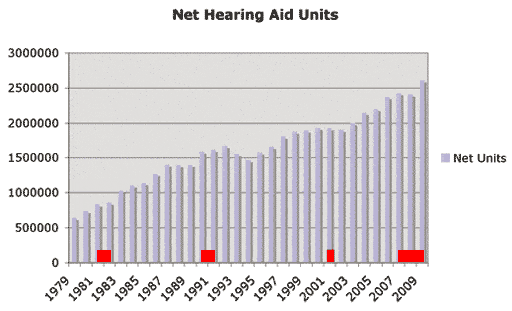
FIGURE 1. Total US net hearing aid units sold, 1979 to 2009. Economic recessions are shown in red. Although certainly not immune to the effects of the economy, unit volume sales are far more sensitive to factors such as periods of government intervention from the FDA (eg, the sales declines from 1993 to 1994).
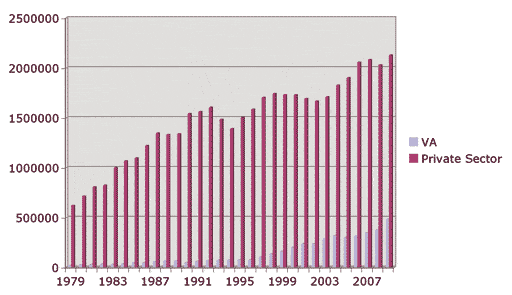
FIGURE 2. Same net sales as above, but with sales of the Dept of Veterans Affairs (VA) and the private-sector (non-VA) market separated.
In general, consumers in 2009 were more skittish about making large purchases, and larger percentages opted for lower-cost devices compared to previous years. Some market analysts believe that the worst period of the recession (the second half of 2008) caused a halving of the premium market (ie, a mass migration to mid- and lower-priced product lines). In a March/April 2010 HR online poll, three-quarters (74.5%) of the respondents said the recession had caused their patients to seek lower-priced hearing aids in 2009.
Not surprisingly, many new product launches in 2009 were aimed at the mid- to economy-line categories. Financing for consumers’ purchase of aids was also an often-mentioned topic in articles and presentations.
Market gains of 5.5% in January-March. In the first 3 months of 2010, private sector unit volume sales grew at a slower-but-steady pace of 2.7%, while the VA increased its dispensing of hearing aids by 18.9%. Overall, this equated to a 5.5% increase in units over 2009.1
TRENDS IN HEARING CARE
The hearing industry is moving fast, and a lot of trends create both obstacles and opportunities—sometimes in equal measures—for dispensing professionals, the industry, and professional organizations. Below, in no particular order, are what might be considered some of the key trends that will continue to shape the hearing care field in 2010 and beyond.
#1) Quality Standards in Practices
Hearing aids work well and few would disagree that quality professional services are the determining factor in the success of a hearing aid fitting, and that these services are the key to professional survival and growth.3 Modern hearing aids require the deft touch and unique knowledge of a dispensing professional to implement and customize them for patients who all have distinct individual needs.
Although most hearing care offices provide exemplary patient care, evidence suggests this isn’t occurring at a consistant industry-wide level. For example, the July 2009 Consumer Reports article4 was widely received by the field as a qualified endorsement for hearing aids and their effectiveness; the article stated that 73% of hearing aid users were highly satisfied with their hearing aids, which approximates MarkeTrak VIII customer satisfaction research (79% of patients being “somewhat satisfied” or better).5 However, the salient message of the CR article was that “consumers pay high prices and get mediocre fittings,” and that the standard of care between offices varies remarkably, with relatively few adhering to the fitting guidelines established by the key professional and consumer organizations.6-9
In last month’s HR, Better Hearing Institute (BHI) Executive Director Sergei Kochkin and 13 co-authors10 correlated successful patient outcomes with 17 procedures in the dispensing armamentarium. The procedures most closely associated with high levels of patient/client success (in order of significance) included:
1) Ensure proper fit and comfort of the hearing aid (eg, quality impressions/earmolds and optimal programming);
2) Achieve good sound quality (eg, use a hearing aid analyzer to assure proper hearing aid function);
3) Keep return visits to a minimum;
4) Have positive dispenser attributes;
5) Have positive office attributes;
6) Verify the hearing aid fitting using real-ear measurement on all patients;
7) Use subjective benefit measurement (eg, COSI, APHAB, etc);
8) Define the patient’s UCLs;
9) Use objective benefit measurement (eg, word recognition, QuickSIN, etc);
10) Administer a customer satisfaction survey;
11) Provide a self-help book;
12) Provide 1 to 2 hours of counseling in the first month.10,11
The study also showed that these items were additive; the more of these steps a hearing care practice employs, the better the chance for a patient’s successful outcome (Figure 3).
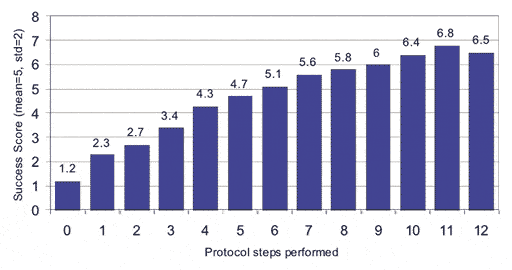
FIGURE 3. Kochkin et al10 showed that total hearing aid user success climbs in a predictable manner as you keep adding more of the steps the study identifies. The difference between using, for example, only 3 to 5 protocol steps compared to a more comprehensive fitting protocol is substantial (n=1,613).
Receiving the most attention has been Item #6, real-ear measurement (REM). A presentation by Laurel Christensen and Jennifer Groth at the 2009 AAA Convention in Dallas showed that not using REM as a routine step was the most-common mistake leading to misfittings.12 This assertion is supported by research reported in a November 2005 HR article by Nancy Aarts and Carrie Caffee showing that less than 12% of measured REAR values are similar to the predicted values shown in manufacturers’ fitting software.13
Researcher and educator Catherine Palmer recently went as far as to suggest that not adhering to best practices—particularly REM—is a breach of ethics.14 Although the “REM debate” dominated the well-attended annual AAA feature session “Evidence Based Hearing Instrument Design,” moderated by Ruth Bentler, what might have been lost during the discussion was that verification is only one facet of a larger picture in the evolving comprehensive evidence-based protocol—a protocol that also includes steps like ensuring proper hearing aid function, programming that takes advantage of the patient’s residual dynamic range, and validation using established outcome measures.
It goes without saying that quality control and high standards of patient care have always been focal points in hearing health care. However, the stakes are getting higher with each year. Automation of the hearing assessment and selection process, remote programming, self-learning algorithms, the FDA’s position on personal sound amplifier products (PSAPs)15 and Internet hearing aids, and the shortage of dispensing professionals entering the field (Trend #7) make hearing health care increasingly susceptible to “disruptive technologies” that could threaten to alter the existing manufacturer-to-dispenser-to-consumer distribution model (Trend #8).
The price of hearing aids and lack of market penetration have also caught the eye of government agencies. The National Institute on Deafness and Other Communication Disorders (NIDCD) recently convened a 3-day working group to develop a research agenda designed to increase the accessibility and affordability of hearing care for adults with mild-to-moderate hearing loss.16 The organizers were careful to state that their goal is to “complement and supplement, not replace, current paradigms and services”; however, one cannot miss the point that alternate approaches are being explored for serving this particular user group.
Abrams et al3 point out that quality service and a continued professional patient-centered culture are the keys to the future. Thus, best-practice procedures and comprehensive protocols that yield highly successful patient outcomes will become a major focus in professional discourse. As a competitive market force, it is even possible that these evolving protocols will play a pivotal role in determining winners and losers at the dispenser and retail chain level.
#2) Retail Consolidation
Although quality control and advanced technology play a major role in the future organic growth of hearing aid companies, forward consolidation—in this case, the purchase of dispensing offices and chains by manufacturers—continues to be one of the most significant market forces of the past 5 years. Most, if not all, major hearing aid manufacturers have been active in purchasing dispensing offices in order to secure volume and smooth sales/production cycles while adding to their companies’ organic sales growth.
For example, a notable acquisition in 2009 was Sonova’s $65 million purchase of Newport Audiology—possibly the nation’s fourth-largest dispensing chain with 360 locations accounting for about 45,000 hearing aid units annually. But this certainly wasn’t the only large purchase of a multioffice dispensing chain during the past 3 years; virtually all major manufacturers have become, in part, practice owners. When considering that the Department of Veterans Affairs accounts for about one-fifth (18.5%) of all the hearing aids sold in the United States, and the manufacturer and network/chain retailers probably account for another 20% to 30%, that leaves between 50% and 60% of the hearing aid market for privately owned dispensing offices (albeit far more in terms of revenue). In fact, Audigy Group founder Brandon Dawson contends that, in a few major metropolitan areas, there are no remaining independent multioffice businesses dispensing large volumes of hearing aids.17
One benefactor of this trend has been the dispensing network groups like Audigy, AHAA, EarQ, HearRite, HearUSA, and Sonus that advertise infrastructure benefits designed to support independent practice owners, as well as provide them with uniquely branded products at volume discounts. Recognizing that business management and marketing are the “short suits” of most private-practice owners, these networks have widened service offerings in recent years, providing everything from bookkeeping and business support to integrated database management and even buyout/transition options and retirement plans. Not surprisingly, their footprint in the industry has grown.
With the limited number of audiology graduates and dispensers entering hearing health care (see Trend #7), forward integration and the growth of chain retailers might also be decreasing independent ownership of practices, as more new professionals are needed in these organizations. While increased demand for professionals is certainly good news for everyone’s career prospects, it potentially impedes the goals of organizations like the Academy of Dispensing Audiologists (ADA), which has stressed the importance of private-practice ownership for the autonomy of the audiology profession.18 Without more private-practice owners and an “ownership culture” (only about 20%-50% of audiologists own a practice), ADA argues that audiology will have decreased influence over its own destiny.
#3) The German Supreme Court, Manufacturer Consolidation, and Industry Newcomers
Okay, I admit it: this trend was considerably farther down my list only a month ago. However, as this edition of HR was headed for press, news broke that the German Supreme Court had reversed an antitrust court ruling that ultimately nixed the 2006 sale of GN (parent company of ReSound, Beltone, and GN Otometrics) to Sonova (parent company of Phonak and Unitron).19 Had that $2.7 billion sale been approved, it would have been the largest acquisition/merger in hearing industry history.
The previous antitrust court ruling that nixed the deal did so on the basis that a new combined GN-Sonova company would have resulted in what the court called an oligopoly, defined as “a market form in which a market or industry is dominated by a small number of sellers (or oligopolists)”—and, ironically, a term that many conspiracy theorists now use to define the German antitrust court system.
Germany is the world’s second largest country in terms of hearing aid unit volume after the United States, making up roughly 10% of the world market. Therefore, the original court ruling essentially prohibited any company with a significant market share in Germany—particularly the Siemens, Sonova, William Demant, and GN groups—from a deal involving each other.
Therefore, the latest German Supreme Court decision reopens the opportunity for major industry consolidation. It’s important to note that GN was quick to state that it is not for sale, and Sonova was quick to state that it is not interested in reviving the deal.
However, in the view of many industry observers, it would be surprising if a major industry merger or acquisition doesn’t take place in the next year or two now that the German ruling is no longer an impediment. Several industry experts have long maintained that, given the small size of the industry (in units) and the cost of R&D and IC chip development, consolidation is inevitable; the only way to really justify the large expenditures is by gains in volume and/or market share. Some even argued that the now-reversed antitrust ruling had served as a artificial roadblock to the “Rule of Three”20 being applied in our industry: the idea that most markets are eventually dominated by about three large generalists with other important players occupying more specialized or even niche roles.
Acquisitions and new entrants in 2009. William Demant Holding (WDH) announced at the 2009 AAA convention the creation of a new company, Oticon Medical, which has since introduced the FDA-approved Ponto bone-anchored implant system to compete with Cochlear Corp’s Baha. WDH also purchased Grason-Stadler Inc (GSI), adding to its diagnostic equipment portfolio that includes Interacoustics and Maico. Sonova purchased cochlear-implant maker Advanced Bionics for $480 million and InSound Medical, manufacturer of the Lyric hearing aid, for $75 million.
Additionally, the industry is not a fixed set of players. Some notable recent entrants in the US market include Hansaton, Panasonic (see HR Online News in this issue), and ExSilent, while several other manufacturers, such as Persona Medical and Sebotek, have redoubled their product and fitting software offerings. There will undoubtably be more to follow.
#4) Open-Fits, RICs & RITEs, and the New BTEs
Prior to 1998, behind-the-ear (BTE) hearing aids accounted for only 19% of the hearing instrument market (Figure 4).1 Although BTEs began slowly gaining market share during the late-90s—possibly due to their advantages in directional fittings—the introduction in 2003 of the ReSound Air, an open-fit mini-BTE, and the Sebotek PAC, a deep-fitting RIC, rapidly accelerated BTE use. Due to these and other innovations like the cosmetically appealing “slim tubes,” BTEs now constitute 64.1% of the entire market (65.7% of the private sector).
Using HIA figures and looking at the use of smaller batteries (sizes 10 and 312), mini-BTEs probably make up around 39% of all the BTEs sold.1 Receiver-in-the-canal (RIC/RITE) BTEs, another subset of BTEs consisting of both mini and standard sizes, constitute 37.8% of the BTEs dispensed. In a February 2009 HR Web Poll, 40% of all respondents said that RICs and RITEs make up more than 40% of all the hearing aids they dispense.
Judging from HR’s online polls and industry statistics, HR estimates that open-fittings constitute just over half (55%) of all fittings. A January 2010 HR Web Poll indicated that about half (48%) of respondents use open-fit hearing aids in 60% or more of their fittings. This is supported by results of a December 2008 Web Poll in which the majority (65%) of respondents said that only one-quarter of their BTEs now employ #13-size tubing or a Libby Horn (ie, not a slim-tube, open, or RITE/RIC fitting).
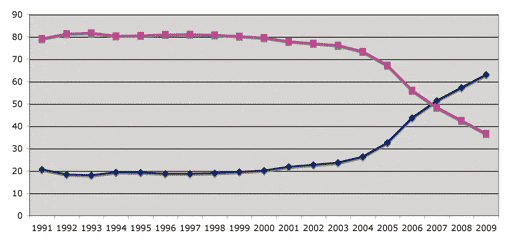
FIGURE 4. Market penetration of BTEs (in blue) versus ITEs (in pink) from 1991 to 2009. After composing about 20% of the market share for more than a decade, BTE popularity rose sharply after 2004. Source: HIA.
Open-fit and RIC/RITE BTEs will continue to increase in popularity—particularly as the VA begins to dispense more of them. These new products, which offer unprecedented sound quality and cosmetics, are great drivers in the continued acceptance of and satisfaction with hearing aids.
#5) Greater Product Specialization for Individual Consumer Needs
With the exception of power aids for severe-to-profound losses, hearing aid product lines have traditionally employed a one-model-fits-all strategy, casting as wide a net as possible with different hearing aid styles. This approach gradually evolved during the digital era, with many hearing aid manufacturers developing “good-better-best” product lines to appeal better to consumers’ financial needs.
However, in the last 2 years, we’ve seen greater product line differentiation as the hearing industry has developed several product lines for the pediatric segment, with features that include extended bandwidths, FM/DAI capabilities, and kid-friendly cosmetics that even include Disney and Nickelodeon characters from Phonak and Starkey, respectively.
Product line differentiation for other distinct user groups may be in the wings, as predicted by Oticon AS President Soren Nielsen in a recent HR article.21 He says these could include, for example, separate product lines designed exclusively for new users: for example, open-fit aids intended for losses of 60 dB or less similar to how Oticon Delta and its successor Epoq were positioned.
One could also envision other product lines for distinct audiences (Figure 5). For example, hearing aids might address the independent-living needs of older seniors and the home-bound, such as those employed in Unitron’s recent Smart Alert™ products that integrate Bellman & Symfon detectors for the doorbell, alarm clock, telephone, and smoke alarms. Another large audience might be those who have both hearing loss and tinnitus, and might find benefit from features like the Widex Zen music synthesizer. Similarly, wireless and cosmetically appealing products might be developed for the younger career-minded “techy” population.

FIGURE 5. Divvying up the product pie? Traditionally, hearing aid product lines have employed a one-model-fits-all strategy, with perhaps only power aids constituting the one true “specialized product niche.” However, during the past 2 years, dedicated pediatric product lines have been introduced. Likewise, the field may soon witness other specialized models and/or feature set packages within models for unique consumer groups like new users, experienced users, and even subsets within these categories catering to the needs of people like musicians, tinnitus patients, younger users, and the home-bound.
Should this come to pass, fitting software will need to become more complex and nuanced with regard to hearing instrument selection—significantly beyond the dBHL and Full-on gain specs—to encompass patient lifestyles, proclivities, and possibly personality and profiling tests.
#6) The VA as a Trailblazer
As mentioned previously, dispensing activity at the VA shot up by 28% in 2009, after increasing by about 9% in both 2007 and 2008 (Figure 6). The VA is now responsible for almost 1-in-5 (18%) of all hearing aids dispensed in the United States.
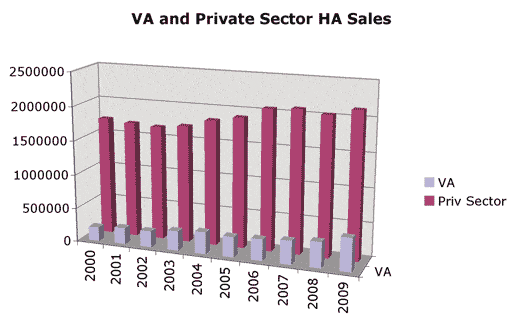
FIGURE 6. VA dispensing activity (net units) compared to that of the private sector. The VA has more than doubled (2.4 times) its units in 10 years from 201,000 in 2000 to 484,000 in 2009. By comparison, non-VA dispensing activity increased by 1.23 times in the last decade from 1.73 million to 2.13 million units. The VA now accounts for 1 in 5 (18.5%) hearing aids sold in the United States. Source: HIA.
According to Lucille Beck, PhD, national director of the Audiology and Speech Pathology Service for the VA, the agency likens the current period to a “shifting paradigm” of casualties from the wars in Iraq and Afghanistan (more than one-fifth of their new patients), which include younger soldiers with blast and head-trauma injuries, as well as an aging population of 23.4 million veterans and another 14 million benefits-eligible people—many of whom also have hearing loss and/or tinnitus. Vietnam vets now make up about 30% of the VA’s hearing aid users. And another telling statistic: 49.9% of the VA’s nearly half-million hearing aids went to first-time users in 2009 compared to about 37% for the private sector. In essence, Dr Beck says the organization is experiencing a “perfect storm” of demand for its services.
The VA has 778 audiologists and 195 hearing technicians at 220 sites who attended to over 238,000 veterans in 2009. Beyond its obvious impact on hearing aid volume, the VA is also one of the primary trend-setters in hearing care. Among many of its research initiatives, it is currently looking at leveraging information technology for remote audiometry and other ways to improve access. In order to provide faster and more accessible care, the VA is also establishing community-based satellite offices along with working with local dispensing professionals to provide hearing-related services.
#7) Shortage of New Dispensers
According to HR’s data, the number of full-time dispensing offices in the United States has remained relatively static, while the hearing-impaired population is growing at 160% of the US population growth.22 Many within the hearing industry privately complain that one of their biggest problems is finding dispensing professionals to fill vacancies and new positions. In the field, those practice owners who opt for retirement often find themselves in a buyer’s market; some sell only their files and close their offices, while others have few options but to sell their practice to a manufacturer or network, some of which have become ersatz practice clearinghouses.
Barry Freeman, PhD, recently published an excellent article titled “The Coming Crisis in Audiology”23 in which he determined via state licensing records that there are a total of 25,145 professionals actively dispensing hearing aids: 9,050 licensed hearing instrument specialists and 16,095 licensed audiologists. However, he estimates that only 12,876 of the audiologists work full-time, so perhaps a more apropos figure is 21,926 dispensing professionals. HR’s statistics of dispensing professionals, based on circulation and dispenser survey figures, is within two percentage points of this latter number.
The editor knows of no statistics on the number of new or entering hearing instrument specialists and non-audiologists. The International Hearing Society (IHS) has reported that they annually receive over 1,000 requests for information about becoming a hearing instrument specialists. Likewise, college programs including Grant MacEwan College, Spokane Falls Community College, and Arkansas State University-Mountain Home—as well as at least four other US and Canadian colleges and various courses—serve as starting points for many people in the field.
Focusing on audiologists, there were about 2,400 students in 75 graduate programs in 2007, with estimates of 400-600 graduates from 2007 to 2011.23 Thus, the number of new graduates represents about 3% to 4% of the existing pool of dispensing audiologists—which hardly seems enough, especially when considering the gender gap issue,24 an aging population, and other factors.
Dr Freeman warns that the shortage of professionals leaves the hearing care field open to “other health care providers [who] may step in or alternate service delivery models.” In his conclusion, he writes:
“…it is clear that under our current system of graduate education and hearing services delivery, the profession of audiology will be challenged in the coming years to meet the anticipated increase in demand for our services. It is time for all audiologists and our professional organizations to become proactive and control our own future before changes in health care and service delivery disrupt our own efforts to manage and treat our patients.”23
Engelmann et al18 in their ADA white paper, Ensuring Audiology’s Future in Healthcare: Owning the Profession Through a Culture of Practice Ownership,18 have pointed out that graduates may not have enough support to become entrepreneurial private-practice owners. A 2007 review of 67 AuD programs found that “31% had no identifiable course listing that resembled business, practice development, or practice ownership education.” Other reports suggest that as many as 61% of residential audiology students plan to own a practice.
In short, it appears that the hearing care field needs to seriously consider how to attract more people to the profession. Likewise, audiology may need to embrace the idea of audiology assistants, like those being trained at Nova Southeastern University and Bellevue University.23,25,26 The growth of the VA and its professional staffing requirements are also certain to figure into the equation.
#8) Health Care Delivery Changes
The traditional hearing instrument dispensing delivery chain has stood the test of time (Table 1)—and with good reason. But the delivery model in general health care is changing rapidly. And, if history holds true for our industry, it will be the consumer who will be the primary driver of change.
For example, the huge “box retailers” (eg, Costco, WalMart Canada, Sears, Cabella’s, etc) are offering hearing aids and/or hearing products. It’s noteworthy that many large retailers are also seeing success with 1-minute drop-in clinics, while pharmacies like CVS and Walgreens offer convenient care clinics that provide basic services for common medical concerns.
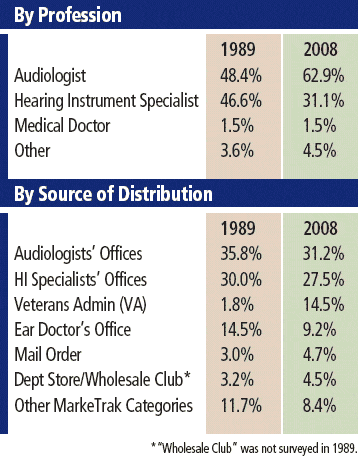
Table 1. Source of hearing aids, as reported by consumers, in the MarkeTrak 1989 and 2008 surveys. Although the hearing care field has changed significantly in terms of the professionals dispensing hearing aids (top), hearing aid distribution by location has not changed as radically—with the obvious exception of the VA. Editor’s Note: One could reasonably include the MarkeTrak categories “Clinic” and “Hospital” in the “Audiologists’ Offices” entry; doing so yields 43.1% for 1989 and 34.5% in 2008 for “Audiologists’ Offices.”
The Internet—through both direct sales and referrals—has also had an increasing impact on hearing aid distribution. Kochkin27 pointed out in the December 2001 HR that the VA and Internet sales are the fastest growing segments of the market. Although an in-depth MarkeTrak VIII article on this topic is scheduled in HR, a reasonable estimate is that more than 1 million hearing aids are purchased online each year, and probably 50% to 75% of these consumers are candidates for custom hearing aids. Internet referral/consolidators like Hearing Planet, AHearingAids.com, and AidRight have also increased their footprint in terms of volume.
Telemedicine and remote programming have made large technological strides over the past decade. Remote audiometric testing, hearing aid fitting, and rehabilitation management are technologically feasible; the devil is in the details. As mentioned previously, the NIDCD is researching affordability and access issues for people with mild-to-moderate hearing losses.16
Robert Sweetow, PhD, recently published an excellent in-depth review of changes in the hearing care delivery system.28
#9) Amazing Breakthroughs in Signal Processing
This probably would be the #1 Trend, except for the fact that everyone reading this article already knows all about it. It’s true that the hearing industry endured some unavoidable criticism in the mid-90s during the introduction of digital hearing aids, as some pointed out that these first-generation aids merely digitized analog features. Few say that anymore.
Without question, feedback and comfort-in-noise issues have been greatly improved with each successive generation of digital hearing aid technology. More recently, a new generation of “smart” hearing instruments have employed algorithms with a dizzying array of capabilities—from replicating the sound-shaping features of the pinna, to assessing the auditory landscape and choosing the best possible listening settings (including phone settings), and even hearing aids that can “learn” how to make adjustments based on the user’s selection of programs and volume levels. Additionally, wide-bandwidth hearing aids with frequency ranges of 8 to 10 kHz are now available, providing important speech cues and hi-fi sound for both children and adults.
The list goes on and on. And it will continue to do so far into the future.
#10) Wireless, Loop Systems, and Getting Closer to Peripherals
One only has to walk around a hearing industry convention hall or page through the ads in HR to see how wireless is transforming hearing aids. BTEs have not only become “instant-fit” devices, but increasingly have the ability to be linked with a constellation of communication devices like cell phones, MP3 players, and even the other hearing aid in a binaural fitting. This reminds us that we are in both the personal communications and hearing health care market—and the boundaries between these two areas will be increasingly blurred (eg, “Is this a hearing aid or a wireless communication device?”). For a primer on wireless systems, see Francis Kuk’s article29 in the March HR.
It’s an unfortunate fact that assistive devices (AD) and peripherals have always played the role of the poor stepchild relative to hearing aids in our industry. For many years, a key challenge of AD distributors has been to get dispensing professionals to see the value-added aspect of these devices and to ignore the thinner margins and need for some kind of “retail sales display” strategy to sell them. However, with the widespread use of wireless, Bluetooth, etc—and increasing numbers of older people who are comfortable with their peripheral devices—ADs may assume a more prominent position in hearing care.
In the February 2010 edition of HR, David Myers, PhD, a hearing aid user and advocate for “looping America,” made a persuasive case for making induction loop technology as universal in America as it is in some European countries. Endorsed by AAA Incoming President Patricia Kricos, PhD, Myers showed how we can vastly increase the multiple environmental listening utility (MELU) that has forever posed a barrier to hearing aid acceptance and use. In Hearing Review Products’ Technology Guide matrices during the past year, one can see that all 35 of the 35 ITEs reviewed contained telecoils, compared to 8 of 10 ITCs, 20 of 42 RIC/RITEs, and even 8 of 57 CICs.
Telecoils are everywhere; increasing the availability of loop systems in public places—in concert with the wide range of wireless features being introduced—creates a great incentive for people to purchase hearing aids, while effectively doubling the utility of hearing aids.
Part 2 of this article will look at 10 more trends in hearing health care.
So, what do you think are the biggest trends? Correspondence can be addressed to Karl Strom at [email protected].
References
- Hearing Industries Association (HIA). Statistical reporting program. Washington, DC: 2010.
- Strom KE. Are we recession proof? Hearing Review. 2008;15(2):8. Available at: www.hearingreview.com/issues/articles/2008-02_07.asp. Accessed April 12, 2010.
- Abrams H, Edwards B, Eiler C, Olson L, Woods WS. The future of hearing health care delivery. Hearing Review. 2007;14(6):52-54. Available at: www.hearingreview.com/issues/articles/2007-06_07.asp.
- Hear well in a noisy world. Consumer Reports. July 2009:32-37.
- Kochkin S. Consumer satisfaction with hearing aids is slowly improving. Hear Jour. 2010;63(1):19-32.
- American Academy of Audiology (AAA). Guidelines for the Audiologic Management of Adult Hearing Impairment. Reston, Va: AAA. Available at: www.audiology.org. Accessed March 9, 2010.
- American Speech Language Hearing Association (ASHA). Guidelines for Hearing Aid Fitting for Adults, ASHA Ad Hoc Committee on Hearing Aid Selection and Fitting. Rockville, Md: ASHA. Available at: www.asha.org/docs/html/GL1998-00012.html. Accessed March 9, 2010.
- International Hearing Society (IHS). A Professional Practice Profile for Hearing Health Professionals. Livonia, Mich: IHS. Available at: ihsinfo.org/IhsV2/Communities_Members/Professional_Practice_Profile.cfm. Accessed March 9, 2010.
- Hearing Loss Association of America (HLAA). Purchasing a Hearing Aid: A Patient Checklist. Bethesda, Md: HLAA. Available at: www.hearingloss.org/LEARN/docs/HLAAHearingAidChecklist_4-14-2009.pdf. Accessed March 9, 2010.
- Kochkin S, Beck DL, Christensen LA, et al. MarkeTrak VIII: The impact of the hearing healthcare professional on hearing aid user success. Hearing Review. 2010;17(4):12-34. Available at: www.hearingreview.com/issues/articles/2010-04_01.asp. Accessed April 12, 2010.
- Strom KE. The nine habits of highly successful dispensing offices. Hearing Review. 2010;17(4):8. Available at: www.hearingreview.com/issues/articles/2010-04_11.asp. Accessed April 14, 2009.
- Christensen L, Groth J. Top ten clinician mistakes in geriatric hearing aid fitting. Seminar presented at: American Academy of Audiology; April 2008; Dallas.
- Aarts NL, Caffee CS. The accuracy and clinical usefulness of manufacturer-predicted REAR values in adult hearing aid fittings. Hearing Review. 2005;12(12):16-22.
- Palmer CV. Best practice: it’s a matter of ethics. Audiology Today. Sept/Oct 2009:31-35.
- Strom KE. Hearing aids and PSAPs. Hearing Review. 2009;16(12):8. Available at: www.hearingreview.com/issues/articles/2009-11_08.asp. Accessed April 12, 2010.
- NIDCD asks how to make hearing health care more affordable, accessible for adults with hearing loss. HR online news, December 11, 2009. Available at: www.hearingreview.com/news/2009-12-11_02.asp. Accessed April 12, 2010.
- Dawson B. Retail consolidation and best practices addressed by Audigy Group. Podcast available at: www.hearingreview.com/podcast/files/PAAA2009041402.asp. Accessed April 14, 2009.
- Engelmann L, Berkey D, Buck T, Syfert G, Tamres M, Williamson S. Ensuring audiology’s future in healthcare: owning the profession through a culture of practice ownership. ADA Feedback. 2008;[Suppl]19(3):1-12.
- German appeals court ruling nixes deal between Phonak and GN. Available at: www.hearingreview.com/insider/2007-08-16_01.asp. Accessed August 16, 2007.
- Sheth J, Sisodia RS. Competitive markets and the Rule of Three. Available at: www.iveybusinessjournal.com/view_article.asp?intArticle_ID=195. Accessed April 12, 2010.
- Strom KE. Oticon renews and energizes its People First strategy with new support tools and launch of Agil. Hearing Review. 2010;17(4):56,65. Available at: www.hearingreview.com/issues/articles/2010-04_12.asp. Accessed April 12, 2010.
- Kochkin S. MarkeTrak VIII: 25-year trends in the hearing health market. Hearing Review. 2009;16(11):12-31. Available at: www.hearingreview.com/issues/articles/2009-10_01.asp. Accessed April 12, 2010.
- Freeman B. The coming crisis in audiology. Audiology Today. Nov/Dec 2009:46-53.
- Nemes J. As the gender gap widens, does audiology need a few good men? Hear Jour. 2005;58(3):19-24.
- Balko J, Michels T. New audiometric technician/hearing aid dispenser online program at Bellevue University, Pts 1-3. Podcast series available at: www.hearingreview.com/bellevue. Accessed April 12, 2010.
- Bloom S. The audiologist’s assistant: assessing a growing trend in practice management. Hear Jour. 2009;62(1):19-25.
- Kochkin S. MarkeTrak VI: The VA and direct mail sales spark growth in hearing aid market. Hearing Review. 2001;8(12):16-24, 63-65.
- Sweetow R. Hearing aid delivery models, Part 1 of 2. Audiology Today. Sept/Oct 2009:48-58.
- Kuk F, Crose B, Korhonen P, et al. Digital wireless hearing aids, Part 1: A Primer. Hearing Review. 2010;17(3):54-67.
- Myers D. Progress toward the looping of America—and doubled hearing aid functionality. Hearing Review. 2010;17(2):10-17.
Citation for this article:
Strom KE. A market update and the top-20 trends in hearing care. Hearing Review. 2010;17(5):12-24.




